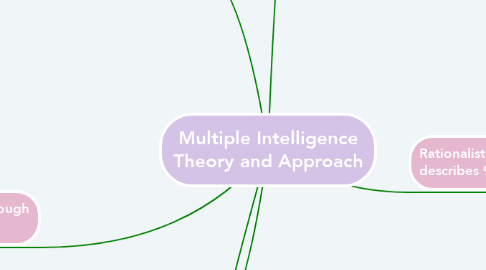
1. The Multiple Intelligence Approach is done in classrooms so that the student has autonomy, creativeness, and entrepreneurship.
1.1. In a school in Catalunya, different levels of education translate into different approaches to fulfill the students' needs in that moment:
1.1.1. Education for infants is centered in stimuli: moving around, experimenting with the senses (touching, smelling...)
1.1.1.1. Visual-spatial, musical-rhythmic, bodily-kinaesthetic and naturalist intelligences are worked in this phase.
1.1.2. Once they get older, they enter the phase to experiment by creating. Certain games are followed so that they intermingle.
1.1.2.1. All the previous intelligences are worked in this phase, as well as the interpersonal and intrapersonal ones.
1.1.3. In primary school, textbooks are out of the picture. The students are the protagonists of their own learning, and they choose what they want to focus in. Every project revolves around cooperativeness and interdisciplinarity, as well as relating information, instead of learning it by heart.
1.1.3.1. All the inteliggences are worked in this phase, and all are evaluated as well.
1.1.4. In high school, learning is focused around cooperative work, and responsibility towards the hours of study and the partners.
1.1.4.1. Interpersonal and intrapersonal intelligences are the focus of this phase.
1.1.5. In the baccalauraute, the student is the one who elaborates all the content. The instructor becomes more similar to a coach, who seeks objectives and eases their learning, but does not provide everything.
1.1.5.1. Interpersonal and intrapersonal intelligences are the focus of this phase, as well as the existential intelligence.
2. Intelligences as personal tools that each individual posseses in order to make sense of any new information.
2.1. Every individual has a different set of intelligences which are above the others. Usually, they are 1-3 intelligences.
2.1.1. Knowing them allows learners to be more responsible, communicative, and motivated in the classrooms.
3. The synapses are formed through experience.
3.1. Therefore, learning, reorganizes the brain, albeit different parts are ready to learn at different moments in life.
3.1.1. Multiple Intelligence Theory is a dynamic construct that understands the diverse array of intelligences as tools that can be trained.
4. Motivation influences on the most evolved intelligences of an individual.
4.1. Varied activities are held in order to comprise at least one of the individuals' intelligences involved, meaning that they will feel more comfortable and pleasant for them.
4.1.1. Therefore, boredom is reduced, while students learn a wide array of presentations and learn on their own, in a context that makes sense.
5. Rationalist model that describes 9 intelligences:
5.1. Mathematical-logical
5.1.1. The ability to use and perceive numbers, as well as understand causality.
5.1.1.1. In the classroom, it means solving mathematic problems.
5.2. Verbal-linguistic
5.2.1. The ability to understand and use words effectively.
5.2.1.1. In the classroom, it means talking, writing, and communicating.
5.3. Musical-rhythmic
5.3.1. The ability to perceive and appreciate rhythm, melody...
5.3.1.1. In the classroom, it means using music.
5.4. Bodily-kinaesthetic
5.4.1. The ability to use the body to express oneself and handle objects.
5.4.1.1. In the classroom, it means role-playing, drama, dancing...
5.5. Interpersonal
5.5.1. The ability to interact and have empathy with other people to cooperate and communicate.
5.5.1.1. In the classroom, it means doing group work effectively, and it is connected to language learning as well.
5.6. Intrapersonal
5.6.1. The ability to understand and explain oneself's feelings and ideas.
5.6.1.1. In the classroom, it means doing group work effectively.
5.7. Visual-spatial
5.7.1. The ability to picture colors, memories, places... in one's mind or through artistic means.
5.7.1.1. In the classroom, it means activities that involve imagining scenes or concepts.
5.8. Naturalist
5.8.1. The ability to distinguish diverse flora and fauna, to enjoy nature, and to have an ecological sensitivity.
5.8.1.1. In the classroom, it means doing activities to identify elements from the vegetal and animal world, or actities about pollution or recycling.
5.9. Existential
5.9.1. The ability to reflect on one's existence and its relationship with others'.
5.9.1.1. In the classroom, it means practising empathy towards others and the world, as well as expressing one's needs.
6. Different ways to apply it to education:
6.1. Teacher Centered Learning
6.1.1. A way to share a lot of information in a short period of time. It involves the engagement and feedback of the whole class.
6.2. Student Centered Learning
6.2.1. Typically done after a new concept has been introduced. It brings choice to the students, who express their understanding of a theme through their favourite intelligence. There are two types:
6.2.1.1. Folder activities, which are done in order to respond to a specific concept following guides (like worksheets).
6.2.1.2. Pinwheel activities, which focus on a topic chosen by the teacher.
6.3. Inquiry Based Learning
6.3.1. Combines teacher and student centered learning; also known as station activities. It is ideal for extending and reinforcing key ideas and concepts.
6.3.1.1. It can consist on short-term activities or long-term projects, in independent or group work...
